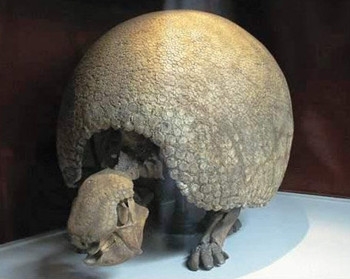
At first sight, manatees might look like seals or dolphins. But in fact, some of their closest relatives live on land. These toenails are the giveaway, remarkably similar to those of elephants.
乍一看,海牛可能看起來像是海報或是海豚。可事實上,他們的一些“近親”卻生活在陸地上。這些腳部化石給了我們線索,他們和大象很可能有“血緣關(guān)系”。
13,000 years ago, two other members of the elephant family roamed this land. The manatees that swim in Florida's springs today are living relatives of ice age mammoths and mastodons.
13000年前,大象家族的兩個分支來到這片陸地。今天在佛羅利達溫泉里游蕩的海牛就是冰河時代猛犸象和乳齒象一個分支的后裔。
Some of the bones found in these springs are easy to identify, but scattering among them are some more obscure remains. What kind of animal could this belong to? These rosettes are bony scales or scutes, similar to those that cover some reptiles today. But this is only one piece of the jigsaw. Imagine what the creature would have looked like when all these pieces were fitted together.
一些在溫泉中發(fā)現(xiàn)的動物骨骼很容易進行辨認,但是他們之中零散的一些話是卻很難辨認。這些化石屬于什么動物?這些蓮座叢是骨鱗,和今天的一些爬行動物很相似。但是這是這些化石殘留中唯一的一片。想象一下,當把這些殘片拼湊到一起,將會是個什么樣的生物?
The scutes, around 2,000 of them, once formed the shell of a huge animal called the glyptodont. With its heavy weight exterior, the glyptodont looks like a reptile, like the alligator, which has been around for millions of years, long before the last ice age.
雕齒獸這種大型動物的外殼上就曾經(jīng)有著2000片左右的骨鱗。它的外表十分沉重,雕齒獸看起來像是一種爬行動物,就像存活了數(shù)百萬年的短吻鱷一樣,但是雕齒獸存于距冰河時代末期前很長的時間。
英文文本來自普特英語,譯文屬可可原創(chuàng),僅供學習交流使用,未經(jīng)許可不得轉(zhuǎn)載.











